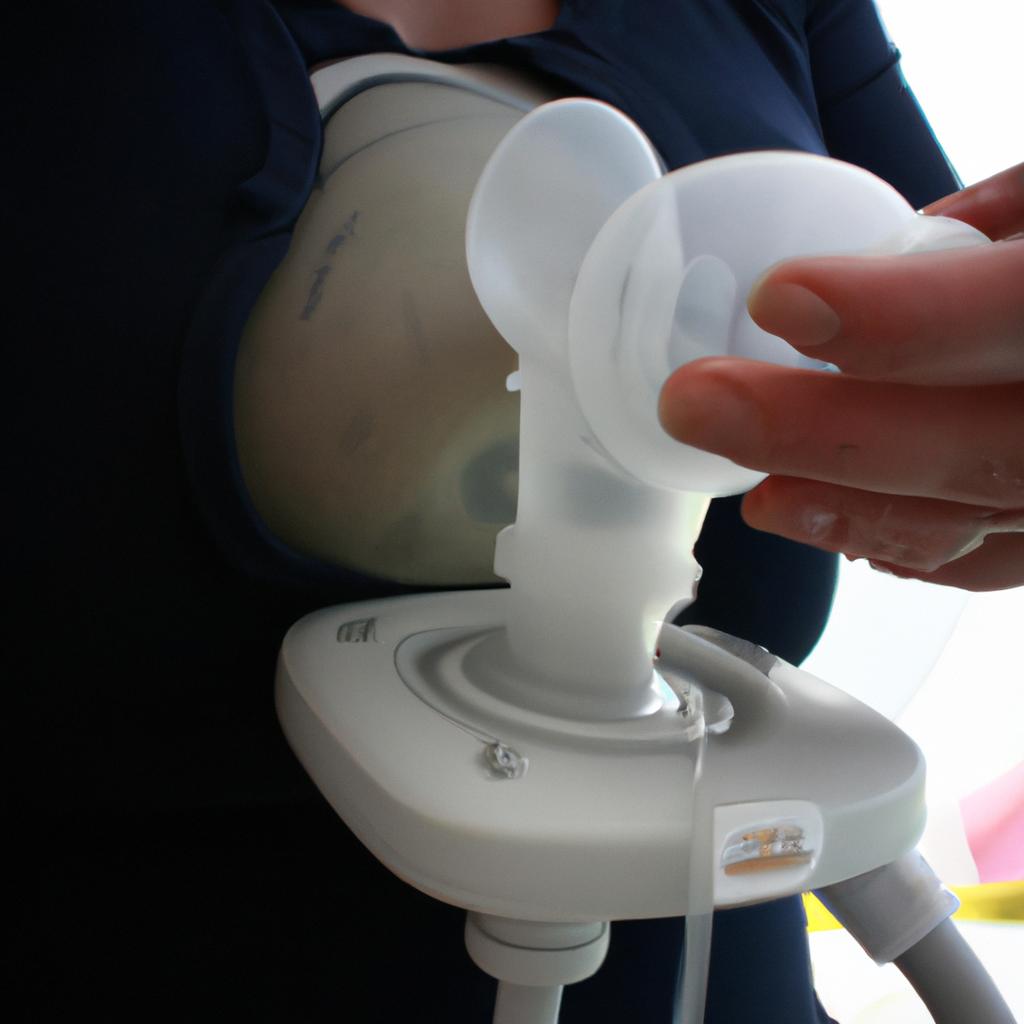Nursing covers have become an essential accessory for mothers seeking privacy and convenience while breastfeeding in public. Let us consider the case of Sarah, a first-time mother who recently visited Baby Country Consignments, with her newborn baby. As she sat down to nurse her little one discreetly, she realized just how valuable nursing covers can be in ensuring both comfort and modesty. This article aims to provide a comprehensive guide on nursing covers, exploring their benefits, types, and tips for choosing the right one.
In today’s society, where breastfeeding is encouraged as the optimal method of infant nutrition, many mothers find themselves faced with the challenge of feeding their babies outside the comfort of their homes. Nursing covers offer a practical solution by providing coverage and creating a private space for breastfeeding sessions. Whether it be at a bustling shopping mall or a cozy cafe, these covers allow mothers like Sarah to nourish their infants without feeling self-conscious or exposed.
Furthermore, nursing covers come in various styles and designs to cater to individual preferences and needs. From apron-style covers with adjustable straps to infinity scarves that double as fashion accessories, there is something suitable for every mother’s taste. Additionally, some nursing covers are equipped with specialized features such as pockets for storing essentials like bur pads or pacifiers, and even built-in wire frames to maintain eye contact with the baby while nursing. These features enhance convenience and make breastfeeding on-the-go easier for mothers.
When it comes to choosing the right nursing cover, there are a few factors to consider. Firstly, comfort is key. Look for covers made from soft, breathable fabrics that won’t irritate your baby’s skin or cause discomfort during feeding sessions. Additionally, consider the size and coverage of the cover. It should be large enough to provide complete coverage without being too bulky or cumbersome.
Another important aspect is ease of use. Look for nursing covers that can be easily adjusted and secured in place, allowing you to nurse your baby comfortably without worrying about slips or gaps in coverage. Some covers come with adjustable neck straps or buttons for easy customization.
Lastly, consider the versatility of the nursing cover. Many covers can also be used as car seat covers, shopping cart covers, or even as scarves when not in use for breastfeeding. This multi-functionality adds value and ensures that you get the most out of your investment.
In conclusion, nursing covers have become an indispensable accessory for breastfeeding mothers who wish to breastfeed their babies discreetly and comfortably in public settings. With various styles and designs available, finding the right nursing cover is a matter of personal preference and practicality. Remember to prioritize comfort, ease of use, and versatility when selecting a nursing cover that suits your needs. Happy breastfeeding!
Choosing the Right Nursing Cover
When it comes to feeding and nursing in public, many new mothers find themselves searching for a solution that provides both privacy and convenience. One option that has gained popularity is the use of nursing covers. These covers are designed to provide a discreet and comfortable environment for breastfeeding babies while allowing mothers to maintain their modesty.
To understand why choosing the right nursing cover is important, let’s consider an example. Imagine a mother named Sarah who recently gave birth to her first child. As Sarah prepares to venture out into the world with her baby, she wants to ensure that she can breastfeed comfortably wherever she goes. She decides to invest in a nursing cover but quickly realizes that there are various options available on the market.
To help simplify the decision-making process, here are some factors to consider when selecting a nursing cover:
- Material: Opt for a breathable fabric like cotton or bamboo that allows air circulation and prevents overheating.
- Coverage: Look for a cover with ample coverage so you can nurse your baby without feeling exposed or uncomfortable.
- Ease of Use: Consider how easy it is to put on and take off the cover while holding your baby.
- Style: Choose a design or pattern that reflects your personal taste and makes you feel confident while using it.
By considering these factors, Sarah can make an informed decision about which nursing cover suits her needs best. To further illustrate this point, let’s look at a table comparing three different types of popular nursing covers:
| Nursing Cover | Material | Coverage | Ease of Use |
|---|---|---|---|
| Apron-style | Cotton | Full | Easy |
| Infinity scarf | Jersey knit | Moderate | Moderate |
| Poncho | Chiffon | Partial | Difficult |
As seen from this comparison table, each type of nursing cover offers unique features and benefits. Ultimately, the choice will depend on Sarah’s personal preferences and specific requirements.
With a grasp on what factors to consider when choosing a nursing cover, it is now essential to explore the different types available in the market. By understanding the various options, mothers like Sarah can assess which type aligns best with their needs and lifestyle.
Understanding the Different Types of Nursing Covers
Transitioning from the previous section on choosing the right nursing cover, it is important to understand the different types available in order to make an informed decision. Let’s delve into this topic further.
Imagine a scenario where a mother named Sarah is searching for a nursing cover that suits her needs. She wants something versatile and easy to use, allowing her to breastfeed comfortably wherever she may be. As Sarah explores her options, she discovers several types of nursing covers designed with different features and styles.
To help you navigate through the variety of nursing covers available, here are some key types to consider:
- Apron-style nursing cover: These covers resemble aprons and typically have straps around the neck for easy adjustment. They provide full coverage while allowing airflow for both baby and mother.
- Infinity scarf nursing cover: This type doubles as a fashionable accessory when not in use as a breastfeeding cover. It can be easily folded or draped over one shoulder when needed.
- Poncho-style nursing cover: Offering generous coverage, these ponchos create a barrier between the mother and surrounding environment, providing privacy while feeding.
- Multi-purpose nursing cover: Combining functionality with versatility, these covers often serve multiple purposes such as car seat canopy, shopping cart cover, or even infinity scarf.
To better visualize the differences among various types of nursing covers, take a look at this comparison table:
| Type | Features | Benefits |
|---|---|---|
| Apron-style | Adjustable straps | Easy to put on and adjust |
| Breathable material | Allows airflow | |
| Infinity scarf | Stylish design | Doubles as fashion accessory |
| Lightweight fabric | Easy to carry | |
| Poncho-style | Full coverage | Provides ample privacy |
| Loose fit | Comfortable during feeding | |
| Multi-purpose cover | Versatile | Can be used for various purposes |
| Saves money on buying multiple items |
Understanding the different types of nursing covers enables mothers like Sarah to choose one that aligns with their personal preferences and needs.
With this understanding of the different types available, let’s now discuss the benefits of using a nursing cover.
Benefits of Using a Nursing Cover
Understanding the Different Types of Nursing Covers can greatly assist parents in finding the perfect one that suits their needs. As mentioned earlier, nursing covers come in various styles and designs. One popular type is the apron-style cover, which provides full coverage at the front while leaving the back open for better ventilation. This style allows mothers to maintain eye contact with their baby during feeding sessions.
Another common type is the infinity scarf cover, which doubles as a fashionable accessory when not in use. This versatile option easily transitions from being worn around the neck to providing privacy during breastfeeding. It offers excellent coverage without drawing unnecessary attention.
Additionally, there are multi-purpose covers that can be used not only as nursing covers but also as car seat canopies or shopping cart covers. These practical options provide convenience and versatility for parents on-the-go.
To further illustrate the benefits of using nursing covers, consider the following examples:
- Increased Privacy: Nursing covers offer a sense of privacy and discretion for both mother and baby.
- Enhanced Comfort: With nursing covers, mothers can feel more comfortable breastfeeding in public settings.
- Reduced Distractions: By creating a barrier between the surroundings and breastfed babies, nursing covers help minimize distractions for them.
- Encourages Bonding: Using a nursing cover promotes uninterrupted bonding time between parent and child.
The table below summarizes some key advantages of incorporating a nursing cover into your routine:
| Advantages |
|---|
| Provides privacy |
| Ensures comfort |
| Minimizes distractions |
| Promotes bonding |
In summary, understanding the different types of nursing covers enables parents to make an informed decision based on their personal preferences and requirements. The variety of styles available ensures that every parent can find a suitable option that meets their unique needs. In our next section about “Tips for Properly Using a Nursing Cover,” we will explore guidelines to ensure optimal usage and effectiveness when utilizing these essential accessories.
Tips for Properly Using a Nursing Cover
Transitioning from the previous section on the benefits of using a nursing cover, it is important to also discuss proper etiquette when utilizing this breastfeeding accessory. Understanding and implementing appropriate behavior while feeding your baby in public can help create a more comfortable and respectful environment for both you and those around you.
For instance, imagine being at a crowded café where families gather for brunch on weekends. As you discreetly nurse your little one under a nursing cover, other patrons may not even realize what you are doing. By adhering to these guidelines of proper etiquette, you can confidently feed your baby without feeling self-conscious or drawing unnecessary attention:
- Respect personal space: When finding a place to nurse with your nursing cover, be mindful of others around you. Choose an area that provides some privacy but avoids obstructing pathways or interfering with the dining experience of fellow customers.
- Be discreet: While nursing covers provide coverage, it is essential to position yourself comfortably and ensure your baby latches properly before covering up. This way, any necessary adjustments can be made beforehand without compromising modesty.
- Respond calmly: In rare instances where someone might express discomfort about breastfeeding in public, respond politely and educate them about its importance. Remember that promoting understanding goes a long way towards normalizing breastfeeding in our society.
- Show empathy: Understand that people have varying opinions about breastfeeding in public. Even if someone seems uncomfortable, try not to take it personally or become defensive. Instead, focus on nourishing and bonding with your child.
To further illustrate how adherence to proper etiquette can positively impact the atmosphere surrounding breastfeeding in public spaces, consider the following table:
| Situation | Improper Etiquette | Proper Etiquette |
|---|---|---|
| Busy airport terminal | Nursing openly without cover | Utilizing a nursing cover for added discretion |
| Restaurant with outdoor seating | Asking for a private room | Finding an inconspicuous spot to nurse |
| Public park | Staring or making negative comments | Ignoring any disapproving glances and focusing on your baby |
| Shopping mall | Drawing excessive attention | Feeding calmly under a nursing cover |
By following these guidelines, you can confidently breastfeed in public while using a nursing cover. Remember that promoting acceptance and educating others about the benefits of breastfeeding is crucial in creating a more inclusive environment for all mothers.
Having discussed proper etiquette for utilizing a nursing cover, it is important to also understand how to maintain its cleanliness and ensure its longevity.
Cleaning and Caring for Your Nursing Cover
Transitioning from the previous section about properly using a nursing cover, it is essential to understand how to clean and care for your nursing cover. Just like any other baby-related item, maintaining cleanliness ensures the safety and well-being of both you and your little one. Let’s explore some tips on cleaning and caring for your nursing cover.
To illustrate these tips, let’s consider the case of Sarah, a new mother who frequently uses her nursing cover while breastfeeding in public places. One day, during a visit to a local park, Sarah accidentally spilled some milk on her nursing cover. Unsure what to do next, she consulted various resources and learned valuable insights into proper cleaning techniques.
When it comes to cleaning your nursing cover, keep in mind the following recommendations:
-
Check the label: Before proceeding with any cleaning method, refer to the manufacturer’s instructions provided on the label. Different materials may require specific care procedures such as hand-washing or machine wash settings.
-
Pre-treat stains: In case of accidental spills or stains on your nursing cover, promptly pre-treat them by gently dabbing with a mild detergent or stain remover suitable for delicate fabrics. Avoid vigorously rubbing the fabric to prevent damage.
-
Choose appropriate washing methods: Most nursing covers are machine washable; however, certain covers made from delicate fabrics might require gentle hand washing instead. Selecting an appropriate washing method will help maintain the integrity of the material over time.
-
Proper storage: After each use and subsequent cleaning session, ensure that your nursing cover is completely dry before storing it away. A damp or moist cover can lead to unpleasant odors or even mold growth if not adequately aired out beforehand.
In addition to these guidelines, here is a bullet point list highlighting key practices for keeping your nursing cover clean and long-lasting:
- Regularly inspect your nursing cover for wear and tear.
- Store it in a clean and dry environment to prevent dust accumulation.
- Avoid using harsh detergents or bleach that may damage the fabric.
- Consider having a spare nursing cover for convenience during extended outings.
To further assist you, we have prepared a table below summarizing different cleaning methods based on the type of material your nursing cover is made from:
| Material | Cleaning Method |
|---|---|
| Cotton | Machine wash with gentle cycle and mild detergent |
| Polyester | Machine wash with cold water and delicate setting |
| Silk | Hand-wash with lukewarm water and gentle soap |
| Bamboo rayon | Follow specific care instructions provided by brand |
As Sarah discovered through her research, knowing how to properly clean and care for your nursing cover ensures its longevity while keeping it fresh and hygienic for future use. By following these tips, you can confidently maintain your nursing cover’s cleanliness after every feeding session.
Transitioning into the subsequent section about alternatives to nursing covers for feeding and nursing, let us explore other options available to cater to various preferences and needs.
Alternatives to Nursing Covers for Feeding and Nursing
Transitioning from the previous section on cleaning and caring for nursing covers, it is important to consider that while nursing covers are a popular choice for many parents, they may not be suitable or preferred by everyone. This section will explore alternative methods of feeding and nursing that offer convenience and comfort in different ways. By considering these alternatives, parents can make an informed decision based on their individual needs and preferences.
One alternative to traditional nursing covers is the use of breastfeeding scarves or shawls. These versatile accessories provide coverage during feeding sessions while also serving as fashionable wardrobe additions. For example, imagine Emily, a new mother attending a social gathering with her baby. She utilizes her stylish scarf to discreetly breastfeed her child, ensuring privacy without drawing unnecessary attention.
To further expand on the options available, let us examine some other alternatives:
- Nursing ponchos: Similar to nursing covers, these ponchos drape over the front of the body providing ample coverage while allowing airflow.
- Button-down shirts: Designed specifically for breastfeeding mothers, button-down shirts offer easy access for nursing without requiring additional coverings.
- Babywearing wraps: When using a baby carrier or wrap, mothers can nurse comfortably and securely by adjusting the fabric around them.
Consider this emotional response evoked through bullet points:
- Feeling confident while nourishing your baby
- Enjoying intimate bonding moments without distractions
- Reducing anxiety about public breastfeeding
- Embracing personal style with functional choices
Let’s now discuss these alternatives in more detail using a table format:
| Alternative | Description | Benefits |
|---|---|---|
| Breastfeeding Scarves/Shawls | Versatile accessories that serve both as fashion statements and practical solutions | – Discreet breastfeeding – Stylish addition to outfits |
| Nursing Ponchos | Drape over the front of the body, providing ample coverage while allowing airflow | – Breathable fabric – Easy to put on and adjust |
| Button-down Shirts | Designed specifically for breastfeeding mothers, with easy access for nursing | – No additional coverings needed – Convenient for daily wear |
| Babywearing Wraps | Allow mothers to nurse comfortably and securely by adjusting the fabric around them | – Hands-free experience – Promotes bonding between mother and baby |
By exploring these alternatives, parents can find a method that aligns with their lifestyle and preferences. It is essential to consider factors such as comfort, convenience, and personal style when deciding which option best suits individual needs. Remember, there are various ways to ensure privacy while feeding or nursing your baby; finding the right approach will make these moments more enjoyable for both parent and child.
Overall, it is important to recognize that nursing covers are not the only solution available. By considering alternative methods such as breastfeeding scarves/shawls, nursing ponchos, button-down shirts designed for breastfeeding, or utilizing babywearing wraps, parents can confidently navigate public feeding situations while maintaining discretion and comfort without compromising their personal style.




